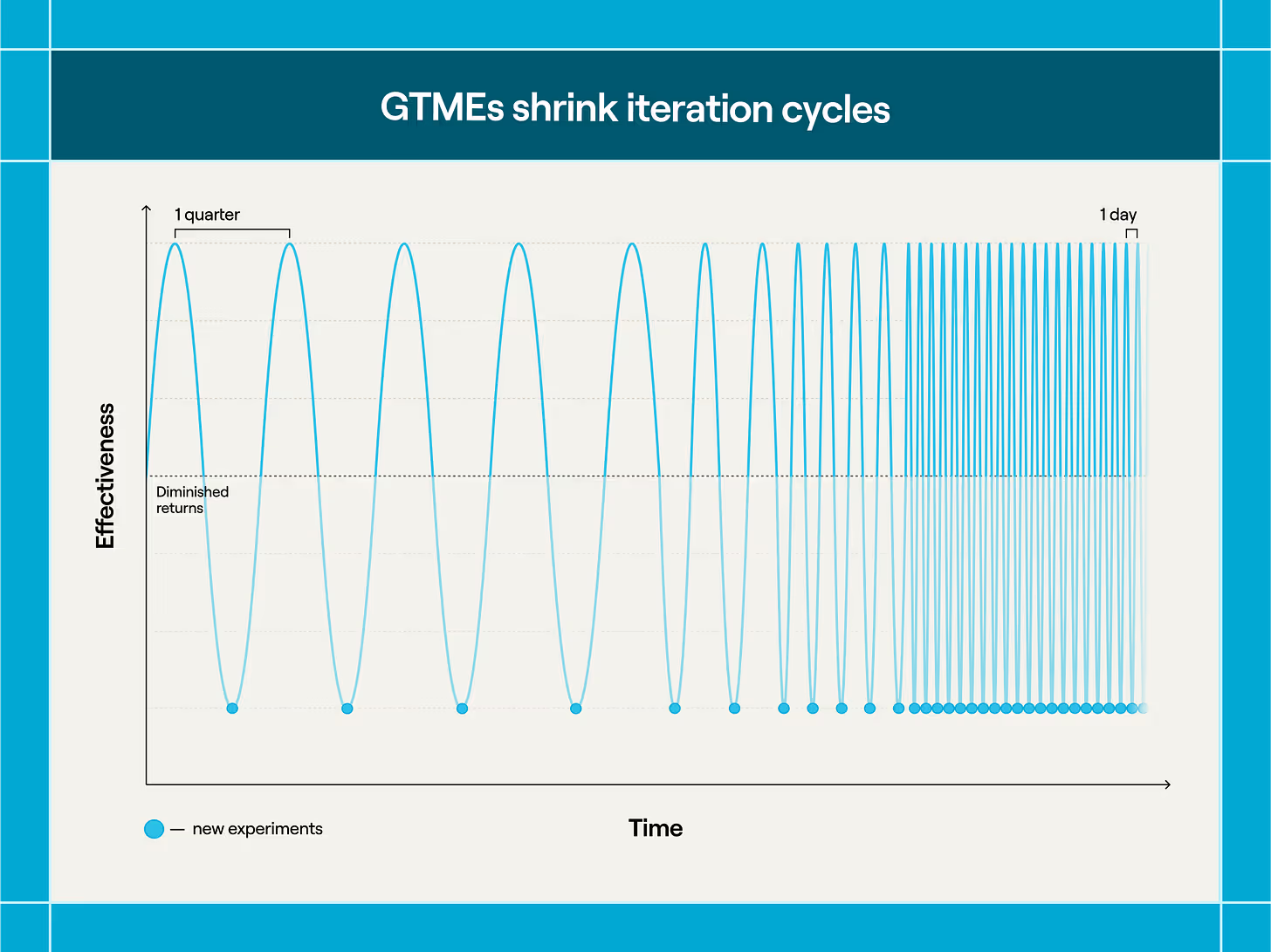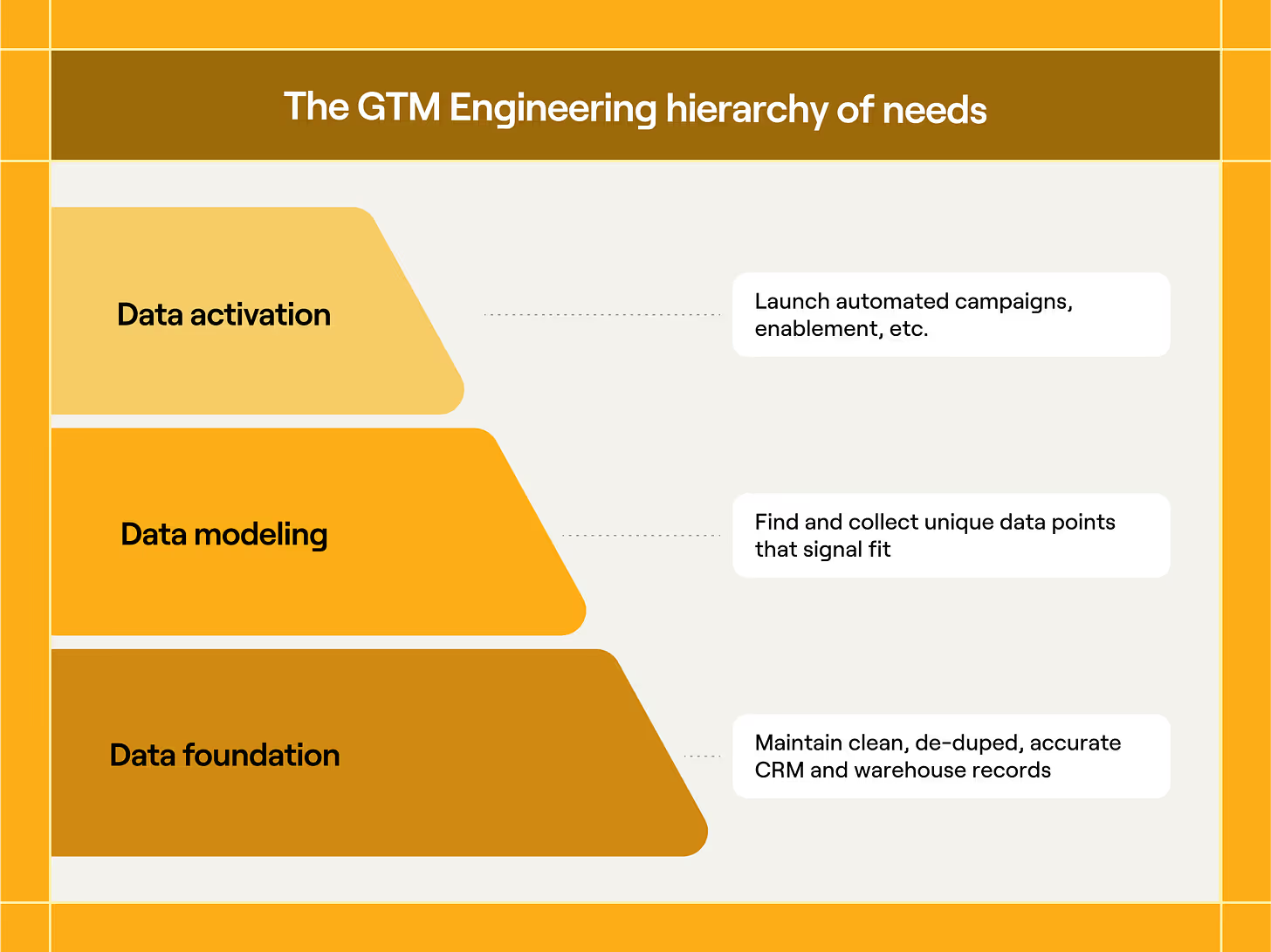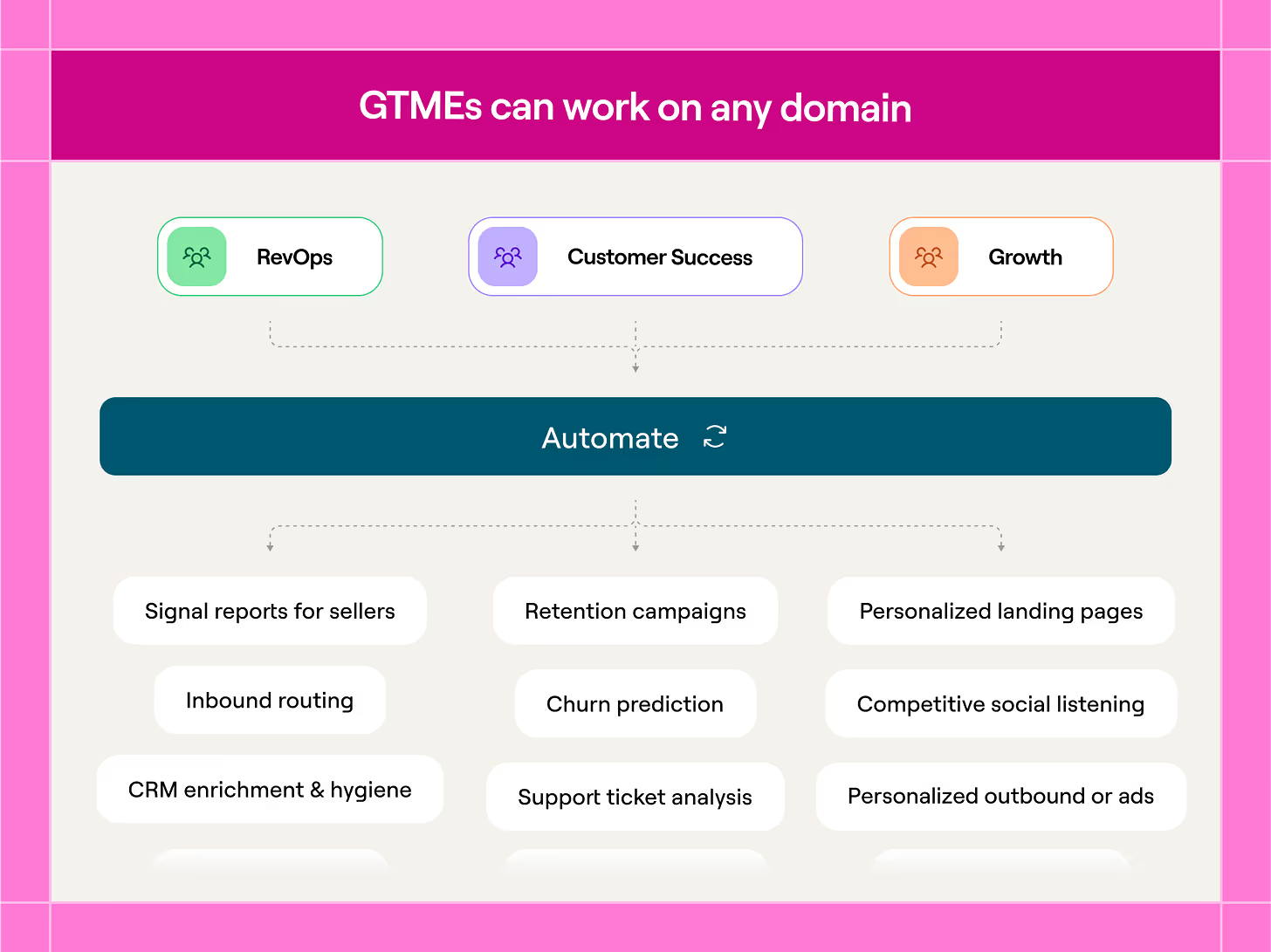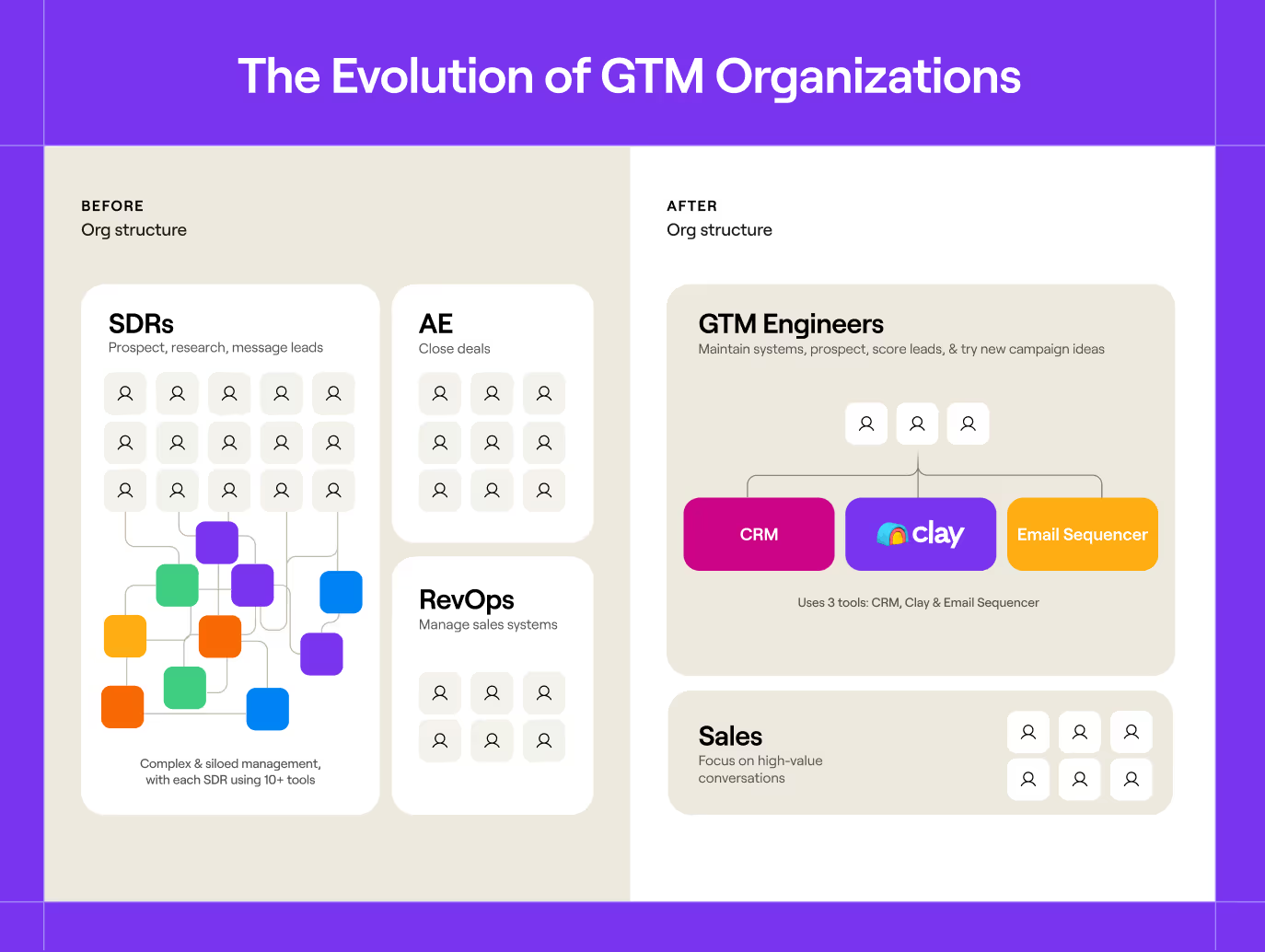- Confluence.VC Weekly
- Pages
- GTM Engineering
The rise of the GTM engineer

Your GTM motion isn’t under-staffed - it’s under-engineered.
If you’re a GTM leader whose team is bogged down by manual research, slow campaigns, or data cleaning, more effort won’t fix things. You need better systems, and GTM engineers are the ones who build them.
GTM engineers build revenue engines using AI and automation. Companies like Cursor, Lovable, and Webflow have been built behind these types of roles., and today, ~100 GTME job listings go live every month.
GTM engineers (GTMEs) can solve problems across any revenue-critical function. That includes:
RevOps: Automate manual seller work (e.g. replace manual account research, update CRMs based on call transcripts, send follow-up emails, etc.)
Growth: Automate demand gen and ABM (e.g. Monitor complaints against competitors on social platforms and launch personalized campaigns within hours).
Customer success: Automate retention and expansion plays (e.g. analyze support tickets to predict churn and send targeted retentive emails).
Ops teams have always been the backbone of revenue teams. Now, with AI, they're stepping into their most strategic era yet. Their job is changing from data plumber to growth architect: someone who tests hypotheses and scales what works, without waiting for developers or manual research. When ops teams turn into GTM engineers, they stop reacting to tickets and start proactively growing revenue.
Why GTM engineering now?
Two shifts made traditional GTM roles and processes obsolete:
First, GTM tactics became commoditized. The sales tactics that worked in 2010 fall flat today. Prospects get hundreds of generic cold emails, and spam filters ignore "quick question" subject lines. Winning companies continuously find a competitive edge, or GTM alpha, with unique data and differentiated plays.
Second, AI eliminated the need for custom manual research and engineering. AI can research thousands of companies at once. APIs can pull data from anywhere. What required either manual research or engineering talent two years ago is now easy no-code automation. This unlocked the ability to test highly targeted, creative approaches at scale.
These shifts created both the need and the opportunity for GTM engineering. The commoditization of tactics demanded creativity. AI made that creativity executable, collapsing the gap between idea and execution from months to hours.
GTM engineers find and fix revenue bottlenecks. They can discover that you should spend resources targeting NYC cafes with $10-20 entrees who just joined DoorDash - and help you reach them tomorrow, not next quarter.

GTM engineering with us
Our GTM engineers act like an internal product team that serves your GTM organization. They identify problems, write specs, ship prototypes, and scale what works, measuring success by metrics like meetings booked and hours saved.
Their work impacts sales enablement, growth marketing, customer success, and more. They both invent new workflows and scale promising tactics from individual experiments. For example, a seller recently built a custom Clay table to track buying signals and draft outreach for top prospects. The GTME team templated the build and rolled it out org-wide within days.

How GTM engineering can solve different domains’ problems
Our GTMEs tackle RevOps, Growth, and CX challenges by first nailing the basics: a clean, trustworthy CRM. Without that data foundation, nothing scales.
Like data scientists, GTM Engineers offer a portable toolkit that only works when the stack beneath it is solid. Their work progresses through three rungs, each building upon the last:
Data foundation: Keep CRM and warehouse records clean, deduped, and trustworthy. (Automated enrichment jobs, schema audits, “merge-and-purge” routines, and ownership rules.)
Data modeling: Collect unique data points that predict purchase, expansion, or churn. (Building propensity scores, defining ICP attributes, and adding AI-data points.)
Data activation: Deploy unique data points in revenue-generating workflows. (Automated outreach, meeting notes, churn-risk or expansion nudges, sales enablement, etc).

Most companies stumble on the first rung. They either try fancy campaigns on incomplete, dirty, or duplicate-riddled data, or waste 80% of their time on data hygiene (updating records, validating info, fixing duplicates) and leave only 20% for strategic work.
GTM Engineers flip this ratio: they automate the hygiene work so teams can spend their hours experimenting and fine-tuning ICP. Below are real builds to show what that means.
Revenue operations & seller enablement
RevOps often focuses on increasing sales efficiency. That could include scoring and replying to inbound interest, auto‑updating your CRM based on call recordings, and more.
Intelligent inbound routing: Manny and Osman’s model scores new sign-ups for $25k-plus potential, auto-assigns the best leads, and even drafts meeting notes and follow-up messages that mention similar customer use cases and custom signals.
Signal digests in Slack: Osman pipes signal digests to individual sellers for account awareness and call prep.
VIP event invites: Spencer cross-references event data with geolocation data to surface perfect event invitees, and automatically follows up on behalf of sellers.
One-click call rescheduling: A reschedule link fires whenever a prospect misses a call to suggest a new time to meet.
Transcript‑powered data entry: Blake’s script listens to calls, extracts firmographics, and backfills Salesforce, so reps don’t waste time in the CRM.
Growth marketing
Growth focuses on demand generation: finding the right prospects, personalizing outreach, and rapid‑testing new channels.
Activation plays: Osman and Manny automated a playbook that lifted trial conversion rates. They also run plays for activated workspaces and new promising customers. Each of these have centralized lead scoring and routing.
Programmatic partner sourcing: Tommy scraped social media and website profiles, scored fit, and launched our influencer marketing program.
Dynamic visitor campaigns: Pranav’s workflow watches reverse‑IP data and triggers personalized emails while interest is hottest.
Customer success & expansion
CX focuses on retaining revenue by spotting risk early and acting on upsell moments.
Ticket‑spike alarms with docs: Bruno’s workflow flags surges in support tickets and drafts the help center articles that prevent the next wave.
CX idea generator: Spencer merged Salesforce and Claygent data to recommend bespoke plays for CSMs to suggest to their accounts.

Smart support routing: When someone contacts support asking for a sales meeting, our system qualifies them instantly and sends a meeting link if they're a good fit—no manual handoff needed.
Expansion radar: Osman scans support threads for enterprise‑only feature requests (RBAC, faster refreshes) and feeds those signals to the account manager before renewal.

Examples of GTME organization structures
Companies implement GTM engineering in different ways (and by different names), though the common goal is to build automated revenue engines. Here are some emerging models:
Model 1: GTME inside RevOps (the dominant pattern)
At most mid-to-large companies, GTM Engineers report into RevOps or GTM ops. The function sometimes splits into prototypers and implementers, where generalists close to sales hack together proofs-of-concept, then engineers harden the winning ideas to touch millions of CRM rows without breaking.
Intercom: Alexander DeMoulin’s GTM Ops team pilots new plays (e.g., TAM enrichment), while GTM Systems, embedded in R&D, scales methods to production.
Canva: Robert Jones’s GTM AI team automates workflows such as transcript summarization, while a separate enrichment team pipes novel data into those plays. Longer-term, Canva may embed GTMEs directly inside sales, marketing, and CX tribes
Notion: Three teams work together to drive RevOps and GTM AI. Evan Peters owns RevOps and Strategy with a GTM innovation pod to build workflows, experiment, and get hands-on commercially (reporting to the CRO). Jalal Iftikhar and Shelley Lee's BizTech and automation engineering teams build foundational GTM systems and scale workflows (reporting to the CFO). Theo Bleier is an embedded AI engineer building and scaling applications (reporting through the CTO).
Anthropic: Everything lives in one GTM Infrastructure & Incentives pod led by Adam Wall. A “Productivity Engineering” sub-squad wields Claude + Clay to automate sales and marketing work.
Why it works: RevOps already owns data pipelines and quality, so lodging GTMEs here draws a straight line from “We spotted a friction point” to “We shipped the fix.”
Model 2: GTME within Growth
A second archetype puts GTM Engineers inside the Growth org.
Ramp houses a Growth Platform squad, led by PMs like Keyan Sarrafzadeh, who partner with Growth Engineering. They run two-week sprints, shipping internal prospecting tools, data aggregators, and AI outreach flows. A separate Business Systems group looks after core Salesforce plumbing.
Verkada keeps its GTMEs in Davide Grieco’s Growth team under the CMO. Their charter is to generate demand and create systems that help the broader GTM organization. That ranges from generating personalized landing pages for ABM campaigns to automating 80% of SDR workflows so they can book 4x the number of meetings per month (80-100 per rep).
Rippling runs GTM engineering within Noah Adelstein's international growth team as well as the US growth team. These teams run frequent growth experiments, including automating outbound and direct mail campaigns.
Why it works: Embedding technical talent beside demand gen unlocks ideas (programmatic landing pages, real-time intent harvesting) that traditional marketers might never attempt.
Cross-model lessons
Start in ops, federate later. Most companies incubate GTM Engineering under RevOps, then push talent outward once foundations are solid.
Balance rapid prototyping with stable implementation. Data engineering skills are often useful when you’re ready to scale experiments that work.
Data hygiene is non-negotiable. Every win traces back to clean, enriched, well-modeled data.

A systems-oriented future
GTM alpha belongs to teams that can build revenue engines with AI. As tools and tactics become commoditized, the edge shifts to how well you can design experiments and scale them fast. Hiring 10 more reps for every 10% pipeline lift won't cut it anymore.

Ops was never meant to live in the back office. Today, the teams closest to your data are also closest to new revenue. GTM Engineers turn ops from support function to growth engine—the connective tissue between product, sales, and marketing. While marketing drives awareness and brand, GTMEs build the infrastructure that turns it into repeatable revenue.
Your revenue problems aren’t people problems. They’re systems problems. And GTM engineers are the ones who fix them.